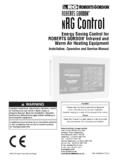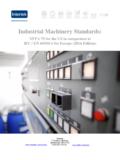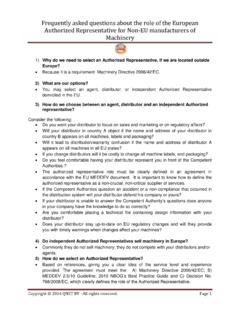Transcription of HSE Approved specifications for fire resistance and ...
1 HSE Approved specifications for fire resistance and hygiene of hydraulic fluids for use in machinery and equipment in mines Reference HSE (M) File October 1999 Contents: 1. 2 3. fire resistance and hygiene Standards for coal Ignition of flammable vapours - flash Spray Fluid soaking into absorbent Ignition by hot Standards for non-coal Ignition of flammable vapours - flash Spray Fluid soaking into absorbent Ignition by hot All Hygiene Continuity of Environmental 4. Identification of fire Sources of 5. Risk Need for risk Reduction of 6. Figure 1 Flowchart summarising fire hazard and risk assessment Appendix A Classification of fire -resistant fluids, their properties and uses ..12 A1 A2 Classification.
2 12 A3 Fluids not A4 Properties and HFA HFB HFC HFD Appendix B fire test B1 B2 Test Ignition of flammable Ignition of a Fluid soaking into absorbent Appendix C Hygiene tests and acceptance C1. Review of available data ..19 Test Effects of long term C2. Oral C3. Skin irritation ..20 C4. Eye C5. Aerosol C6. Thermal C7. Neurotoxicity (phosphate esters only)..21 Appendix D Equivalent or corresponding 23 Appendix E Drafting and consultation ..24 Appendix F Regulation 8 of the mines miscellaneous health and safety provisions regulations 1. Foreword This document has been prepared in support of Regulation 8 of the Mines Miscellaneous Health and Safety Provisions Regulations 1995, (the Regulations).
3 The Regulations implement European Council Directive 92/104/EEC (the Extractive Industries Directive) and in particular Part C, Clause of the special minimum requirements applicable to underground mineral extracting industries concerning fire -resistant fluids. Regulation 8(1) of the Regulations refers to the use of Approved specifications relating to fire resistance and hygiene for hydraulic fluids1 used at a mine. For the convenience of the reader Regulation 8 is reproduced at Appendix F. This document includes a minimum requirement for coal mines. It also sets out a methodology by which compliance with Regulation 8 may be achieved by the selection of fire -resistant fluids or by other means based on Risk Assessment.
4 It is concerned principally with fire resistance and hygiene properties, and does not cover other properties of fire -resistant fluids such as corrosion prevention, compatibility with elastomers and other such The document additionally seeks to provide guidance to mine management and to the workforce on the different types of fluids available for use in mines and their properties. 2. Scope This document gives requirements for fire resistant fluids intended for use in all underground mines and gives guidance on achieving a minimum level of safety in their end use application. The performance requirements set out in certain test specifications in this document are those that have been found to give an adequate level of safety.
5 More information on these requirements and on the properties of fire -resistant fluids can be found in Appendices A to C. 3. fire resistance and hygiene standards The following sub-sections set out standards for safety based on the test methods identified in Appendices B and C. The approach taken has been to specify a level of performance that would be necessary to provide operational safety where the risks present arise from difficulties of access and egress in underground situations and where sources of ignition are assumed to be present. 1 For the purposes of this document hydraulic fluid means a fluid used for the transmission of hydrostatic or hydrokinetic mechanical energy.
6 This is the same definition as that given in the Mines Miscellaneous Health and Safety Provisions Regulations 1995 2 Information on these other properties may be found in documents such as the 7th Luxembourg Report, ISO 12922 and British Coal specifications 463 and 570. The standards give the minimum level of performance requirements for UK coal mines (see ) that have been used over many years and therefore proven to be reasonably practicable to comply with (See Regulation 8 at Appendix F). Section should also be used where additional hazards such as the presence of flammable3 atmospheres, flammable dusts or fuel sources additional to and greater than that from the fluid alone are present. For non-coal mines and where some of the above factors are absent there are no additional sources of fuel or there are no flammable dusts present or where additional safety measures are in place information is given on the risk assessment procedures to be followed (see ).
7 For all mines it is necessary to carry out a final risk assessment after considering all of the performance requirements. Wherever practicable fluids that comply with as many of the fire performance requirements as possible should be used. For all mines the specifications give the minimum standards for hygiene hazards (see ) and continuity of properties during use (see ). Guidance is also given on environmental assessment ( ) A flowchart, which is designed to clarify and summarise the process of fire hazard and risk assessment for the selection of a suitable fluid, is presented as Figure 1 on page 14. For the purpose of the fire hazard and risk assessment process given in this section and in Figure 1, if a decision is made not to undertake any particular test it must be assumed that the fluid has failed the test and, in the case of the spray ignition test, obtained an ignitability index (RI) of less than 25.
8 Standards for coal mines Ignition of flammable vapours - flash point When measured by ISO 2592 (the Cleveland open cup flash point test) the flash point of the fluid should exceed 200 oC. Additional information on this test is given in Section of Appendix B. Spray ignition When tested by the method given in ISO 15029 Part 1 (the Hollow cone nozzle method) the fluid should record a pass . When tested by the method given in ISO 15029 Part 2 (the Stabilised flame heat release method) the fluid should record an ignitability index, RI, greater than 254. Additional information on these tests is given in Section of Appendix B. 3 For the purposes of this Document the term flammable when used in relation to vapours and dusts should be taken to mean that these substances will ignite and have the potential to spread flame.
9 4 It is accepted that performance in ISO 15029 Part 1 is not necessarily related to performance in ISO 15029 Part 2, however the value of 25 for RI has been set on the basis of existing experience of testing fluids that have been in widespread use in coal mines. It should be taken as the appropriate level until further information or research indicates that another value is appropriate. 2 It has been found that a pass by the method given in ISO 15029 Part 1 (equivalent to the spray test in British Coal specification 570) has given an adequate level of safety in UK coal mines and in conjunction with a pass in BS EN ISO 14935 (the Wick test, see below) continues to be the minimum level of performance required for those mines. Fluids that have been in widespread use in coal mines have also been found to give an ignitability factor (RI) greater than 25 (see Note 4).
10 The total enclosure of hydraulic systems in, for example, a cast steel machine casing, so that they are inaccessible to sources of ignition and it is unlikely that fluid will spray into the surrounding atmosphere, has been found to give a safe situation for the use of mineral oil hydraulic fluids in UK coal mines. The Stabilised flame heat release test in ISO 15029 Part 2 should be used for all fluids proposed for use in mines because of the superior level of information it is able to provide for risk assessment. Fluid soaking into absorbent material The fluid should record a pass when tested according to the method given in BS EN ISO 14935 (the Wick test). Additional information on this test is given in Section of Appendix B. The total enclosure of hydraulic systems in, for example, a cast steel machine casing, so that they are inaccessible to sources of ignition and unlikely to leak fluid onto other flammable materials has been found to give a safe situation for the use of mineral oil hydraulic fluids in UK coal mines.














